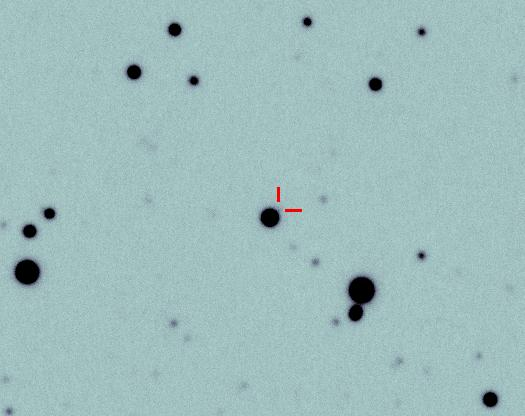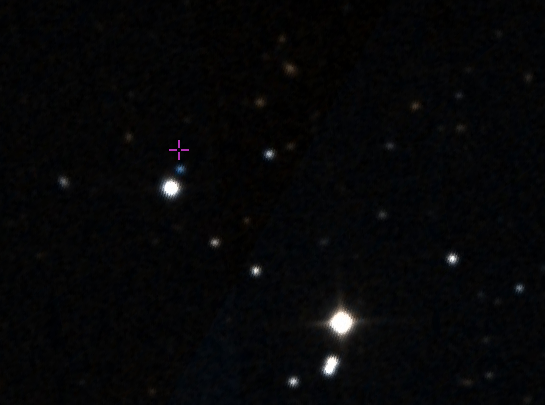› Forums › Variable Stars › Fast moving White Dwarf
- This topic has 11 replies, 5 voices, and was last updated 5 years, 3 months ago by
 Dr Paul Leyland.
Dr Paul Leyland.
-
AuthorPosts
-
15 July 2020 at 9:20 am #574673
 Jeremy ShearsParticipant
Jeremy ShearsParticipantProfessor Boris Gaensicke (U of Warwick), a great friend of the Variable Star Section, was interviewed on the BBC Today programme this morning. He was speaking about a fast moving white dwarf which he thinks might have been ejected from a partial supernova. You can hear it on BBC Sounds catch-up, starting at 1 h 44 minutes into the programme.
The MNRAS paper on “SDSS J124043.01+671034.68: The partially burned remnant of a low-mass white dwarf that underwent thermonuclear ignition?” reporting the discovery is here.
A popular account in Forbes magazine is here.
It’s not often ones gets to listen to an item on white dwarfs on national radio over cornflakes and marmalade!
15 July 2020 at 10:44 am #582831 Jeremy ShearsParticipant
Jeremy ShearsParticipantThanks David. I am glad you are maintaining your catholic tastes in print media. What a crazy article! I always remember Patrick citing Oph as the 13th sign of the zodiac in his debunking of astrology.
BTW, Cornflakes and marmelade was my inclusive short-hand for breakfast, which in my case is “Dorset cereals seriously nutty muesli”, with banana, blueberries, low fat Greek yoghurt, and semi-skimmed milk, but I thought that might sound a bit too bourgeoisie.
15 July 2020 at 11:51 am #582830 David SwanParticipant
David SwanParticipantThanks Jeremy (although I’m slightly disturbed by the juxtaposition of marmalade and cornflakes). On a hilarious note, please read this article published yesterday:
https://www.dailymail.co.uk/debate/article-8523421/Has-star-sign-wrong-along.html
Apparently NASA discovered Oph just a few years ago. And what exactly has C/2020 F3 (NEOWISE) got to do with anything in relation to the rest of the article? A hoot.
15 July 2020 at 12:40 pm #582832 Nick JamesParticipant
Nick JamesParticipantDavid, I hold you personally responsible that I now have to hoover out my keyboard after reading that Daily Mail article while eating my lunchtime sandwich. Do they actually pay their astrologer to write this stuff? I have to admit though that “Comet Neowise” is certainly having a significant influence on my life at the moment.
15 July 2020 at 2:11 pm #582833 Jeremy ShearsParticipant
Jeremy ShearsParticipantWe can relax now because the BBC has the definitive news item on its website and this object.
16 July 2020 at 8:15 am #582838 Daryl DobbsParticipant
Daryl DobbsParticipantSo BAA is an acronym for Breakfast Appreciation Association
16 July 2020 at 8:31 pm #582846 Dr Paul LeylandParticipant
Dr Paul LeylandParticipantSDSS 124043.01+671034.68 is relatively bright at Gaia g=18.44 so I’ll see whether I can take an image when I’m back at my observatory in a week or so. There is a g=12.68 star 15 arcsec distant and I hope that the scattered light from it won’t cause too many problems.
Watch this space.
26 July 2020 at 12:33 am #582922 Dr Paul LeylandParticipant
Dr Paul LeylandParticipantTonight was the first session of this stay in La Palma. I imaged the field and there is something there but the WD is rather drowned out by the bright star.
Not a very good night with some moon-lit haze and high winds, which makes for poor seeing at this site. The relatively low altitude of the star (30-33 degrees tonight) at this latitude most certainly does not help.
I will process the data tomorrow and see whether there is anything worth posting.
26 July 2020 at 9:44 pm #582933 David SwanParticipant
David SwanParticipantGood effort though, Paul. I look forward to seeing the definitive result when conditions have improved.
27 July 2020 at 9:06 am #582927 Dr Paul LeylandParticipant
Dr Paul LeylandParticipantAs expected, the image is not very good. The 19 minute exposure in ~5 arcsec FWHM seeing was not long enough for an 18.4 magnitude object only 15 arcsec from a star six magnitudes brighter.
The position of the WD is marked, the star is just about visible but not obvious. For comparison a snippet of the DSS2 image is included. The fainter (north-easternmost) star between the two brightest is mag 17.8 in Gaia DR2. The poor seeing is especially well demonstrated by the inability to resolve the ~6 arcsec double which is visible in the DSS2 image.


I will try again with a longer exposure in much better seeing conditions before uploading to my personal web page.
27 July 2020 at 11:09 pm #582940 Jeremy ShearsParticipant
Jeremy ShearsParticipantA good start Paul. Hope you get better conditions that will allow you to go a bit deeper on this target.
5 August 2020 at 11:12 am #582970 Dr Paul LeylandParticipant
Dr Paul LeylandParticipantSo do I. The calimas around here have been dreadful recently. Last night had noticeably better seeing but poor transparency. Saharan dust and a full moon are not conducive to good imaging. Some more data was taken, down to an altitude of 20 degrees this time, but my expectations are not high.
-
AuthorPosts
- You must be logged in to reply to this topic.
